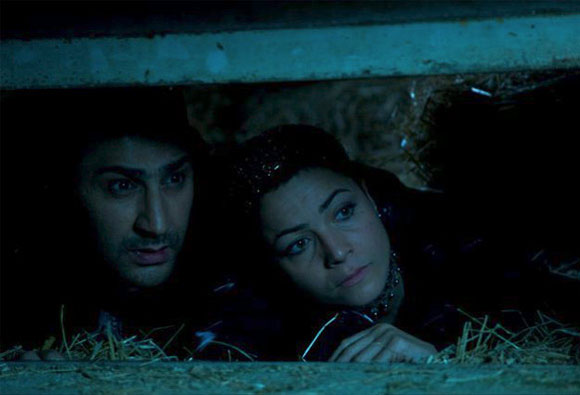My Tehran for Sale

(L-R), Amir Chegini as Saman and Marzieh Vafamir as Marzieh in Cyan Films' MY TEHRAN FOR SALE.

Marzieh (Marzieh Vafamehr) is a young performing artist in Tehran. Behind the veil of Islam, a community of Iranian youth fills underground raves blasting Hindi bhangra. Here, Marzieh meets a young Persian, Saman (Amir Chegini), visiting from Australia. During a police raid, the two escape to a nearby stable. Those arrested, including Marzieh’s friend Sadaf (Asha Mehrabi), are taken to a back room at the station and lashed multiple times.
“This doesn’t affect you people,” Marzieh says to the emigrant Saman. “You mean you look older and I’m still young,” he replies. From 1980 to 1988, Tehran suffered barrages of missile attacks for which we Americans have little to no direct frame of reference—a constant state of war on home soil. It certainly seems that many in war-torn countries age much faster. It shows. Marzieh’s facial expressions range mostly from tired to exhausted—only occasionally broken by the playfulness of a friend’s daughter.
Well before the other shoe drops, we get a sense of impending doom. Marzieh has a clock ticking—not that one. She’s working against several clocks, in fact. One is a play she and her colleagues are opening, an abstract performance in which her character is pushed and pulled by forces beyond her control. Likewise, forces strain several of Marzieh’s relationships—with Saman, her estranged mother, her art and her country. Somewhere in the backdrop lurks a shady figure vaguely resembling Gene Shalit—sans alliteration, waiting to sell her a way out.
Writer/director Granaz Moussavi focused so heavily on showing us the different sides of Tehran as a setting that in her first attempt at a feature she hasn’t quite grasped the necessity for narrative cohesion. The story jumps around so many times and places, without at least basic visual or thematic cues to orient us in the chronology.
More troubling is the plot contrivance that brings us to the resolution. Marzieh is portrayed as an otherwise intelligent, progressive woman. Yet, here she is, oddly clinging to a man whose character is revealed quite succinctly in one shot: An old man by the coulee basks briefly in the sunny breeze, suggesting an affinity for the simplest pleasures. Saman, by contrast, adjusts his trendy (read: hilariously large) sunglasses, lights and holds a cigarette with such care we feel as if he’s emulating a movie star. His sense of aesthetics is superficial, employed exclusively to convey his opinion of himself. The old man’s sense of aesthetics is life-sustaining. He takes enjoyment in whatever he can, as he hasn’t the luxury to enjoy much else.
Marzieh would willingly have sacrificed everything and everyone she knows and loves for a man she met at a rave—hard to say how long ago because of the jumbled, uncorrelated sequences. Any feminist message intended by Ms. Moussavi—herself educated at the Sorbonne—is undercut by Marzieh’s perverse, needy obsession with Saman. She only embraces the value of her native culture (flaws and all) out of resignation, not by any measure of sensibility.
My Tehran For Sale premiered at the Adelaide Film Festival in Australia, February 2009, and was exhibited this week at the 2010 Dallas International Film Festival.
 My Tehran For Sale • Dolby® Digital surround sound in select theatres • Aspect Ratio: 1.78:1 • Running Time: 96 minutes • MPAA Rating: Not Rated.
My Tehran For Sale • Dolby® Digital surround sound in select theatres • Aspect Ratio: 1.78:1 • Running Time: 96 minutes • MPAA Rating: Not Rated.